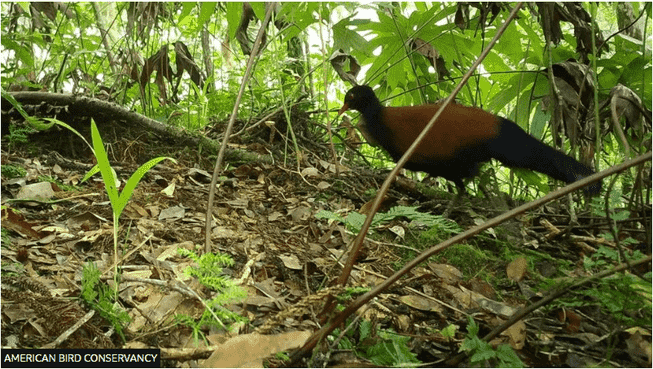No biologist has seen the rare Fergusson’s pheasant dove since 1882. Now she has been found again off the east coast of New Guinea.
For the first time since 1882, the existence of the Fergusson’s Pheasant Pigeon has been documented.
In times of climate change and global species extinction, good news from the world of science is a rarity. But there are bright spots.
Until recently, the Fergusson pheasant pigeon was considered (Otidiphaps nobilis insularis) from New Guinea as missing. No biologist had seen the bird since 1882. But now an expedition team from the American Cornell University has succeeded in scientifically proving that the bird, sometimes also called the black-naped pheasant dove, is still alive.
This is reported by the bird protection organization American Bird Conservancy (ABC). Together with other groups and institutions, she launched the project “The Search for Lost Birds”. The organization has set itself the goal of rediscovering various lost bird species over the next few years.
Week long search
And there are quite a few of them. The survival status of many rare species is often unclear, especially in remote and hard-to-reach places around the world. Scientists looking for such species therefore usually need a bit of luck to track down their target object.
This was also the case with the Fergusson pheasant pigeon. The Cornell University team had already tried to find the bird in 2019 – but without success. Only reports from local hunters in recent years have indicated that the rarest of the four subspecies of the pheasant dove still exists.
The bird, which grows to be about the size of a small domestic chicken, is very secretive and only found on Fergusson Island in the D’Entrecasteaux Archipelago off the east coast of Papua New Guinea. The island is difficult to access. Dense forests and a highly rugged landscape make expeditions difficult.
These conditions nearly ended the last expedition, as Jason Gregg, co-leader of the expedition, told the BBC. They had been looking for the bird for weeks in September. The discovery was only made two days before the planned departure thanks to a crucial clue. A hunter from a small village on the west side of Mount Kilkerran told the scientists that he had seen the animals several times in steep mountain terrain and heard them calling.
The scientists finally placed twelve camera traps in the described area – and they were successful. A pheasant pigeon walking through the dense undergrowth was caught on camera. The bird stayed at an altitude of 1000 meters above sea level.
Scientists have succeeded in filming the first ever film of a Fergusson’s pheasant dove off the coast of Papua New Guinea.
The joy of the discovery among scientists and ornithologists is huge. For the first time in 140 years, the existence of the species could be proven again. John Mittermeier, director of ABC’s Lost Birds program and co-leader of the expedition, told the BBC: “We had been looking for the bird for a month. When we saw the first photos of the pheasant dove, it felt like we had found a unicorn.” It is the moment that conservationists and bird watchers dream of all their lives.
Probably fewer than 250 specimens alive
The future of the bird is still not good. Because of the small habitat and because the species is probably also hunted, the researchers assume that the birds are threatened with extinction. Birdlife International and the International Union for Conservation of Nature (IUCN) estimate the total population at fewer than 250 individuals.
Nevertheless, the find inspires confidence. Scientists hope it will help save the species from extinction.
